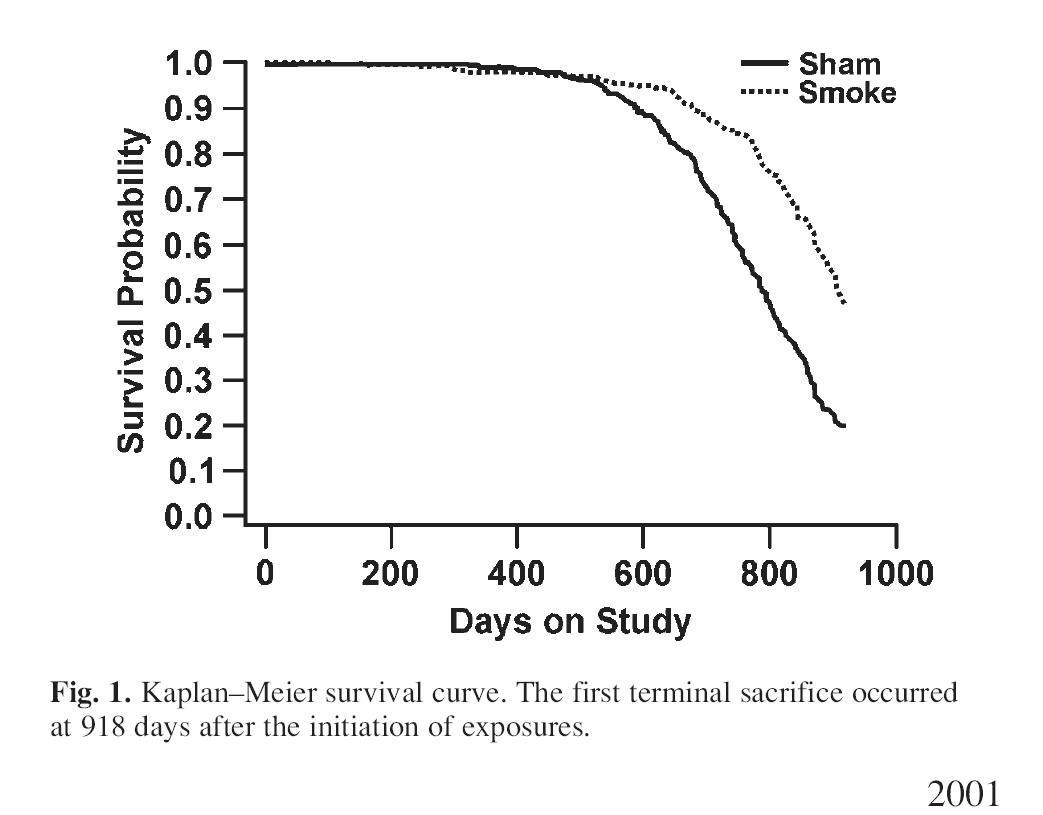1) This time they used different breed of genetically optimized cancer mice, the B6C3F1 mice. These ones develop cancers spontaneously in virtually all tissues and organs, albeit comparatively less in lungs than F344 rats, and die from it by age of 2 yo.
2)These spontaneous cancers proliferate the most wherever there is the best blood supply. Since the combination of nicotine and nitric oxide in tobacco smoke stimulates vascular growth factor as well as circulation (Viagra effect of NO), the best blood supply for growth of these neoplasias will be wherever there was the greatest contact with tobacco smoke (nasal cavity, trachea, lungs). Of course, there will be less blood elsewhere, hence the slower growth of tumors there, as the paper notes on page 2006).
3) The refinements from their 2004 experiment, in which the low exposure group had 100 mg/m^3 of smoke particles and high exposure group 250 mg/m^3, was that this time they used 250 mg/m^3, which is near asphyxiating exposure level and about 15-20 times greater intensity than particulate levels a human smoker experiences (due to 6 hour/day exposure, 5 days/week they estimate exposure as equivalent to 4 packs/day, albeit all smoked in 6 hours and no breaks between cigarettes). Note that this same research group conducted similar experiments on carcinogenic effects of diesel fumes (which indeed do cause lung cancers) using 0.35 to 7 mg/m^3 smoke particles, which is 36 times lower concentration than the one used in this tobacco smoke experiment. Interestingly, this time they picked only female mice and only at 250 mg/m^3 exposure level, which was precisely the combination that fared the most poorly in their 2004 experiment (in that case many F344 female rats in 250mg/m^3 group died shortly into the "experiment" from plain asphyxiation).
4) As before, their experiment backfired showing again that the smoking mice, despite living their entire life under the nearly asphyxiating levels of tobacco smoke, lived longer than the control group (sham exposure):  Buried deep on page 2006, they admit in words the real finding on the effect of tobacco smoke on the health & longevity:
Buried deep on page 2006, they admit in words the real finding on the effect of tobacco smoke on the health & longevity:
"In spite of the higher lung tumor incidence and multiplicity in CS-exposed mice, survival of these mice was significantly longer than for the sham-exposed mice. Longer survival in the CS-exposed mice is likely a sequela of the lower incidence and delayed onset of other types of fatal neoplasia, in part due to the reduced body weight in these mice."
In short: Miracle medicine tobacco 1: Big Pharma 0.
You can also check a more detailed discussion of this type of experiments and their precursors in that earlier thread.
Summary: Here we have in Anno Domini 2005, a would be crowning experiment, half a century into this latest antismoking wave of futile attempts at using hard science to show any actual harm of smoking. With all the Pfizer's and other Big Pharma and government bucks and contractors behind it, this is what they got to show -- the female genetic cancer mice, hugely overexposed and in the worst possible way (6 hours of continuous asphyxiating concentration, like chain smoking 4 cigarettes simultaneously and without a second of a break for 6 hours a day), ends up living longer than non-smoking mice.
If that is the best they can do, smoking is even better for you than anyone ever suspected. How do you make the most potent and most beneficial medicinal plant humans have ever known appear bad within hard science? As seen here, it plainly doesn't work and it can't be done, no matter how much money and research man-years they pour into that pursuit. They are pretty much stuck with what they have been doing in mass media and schools last fifty years -- parroting the thousand and one variants of the same statistical correlations between various diseases and smoking which are by themselves mere hints of possible causality, being equally consistent with causal and protective/therapeutic role of tobacco smoke. The hard science tells which one it is -- smoking is good for you.